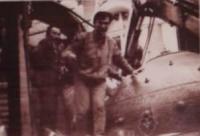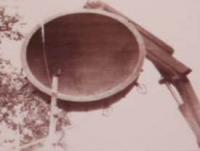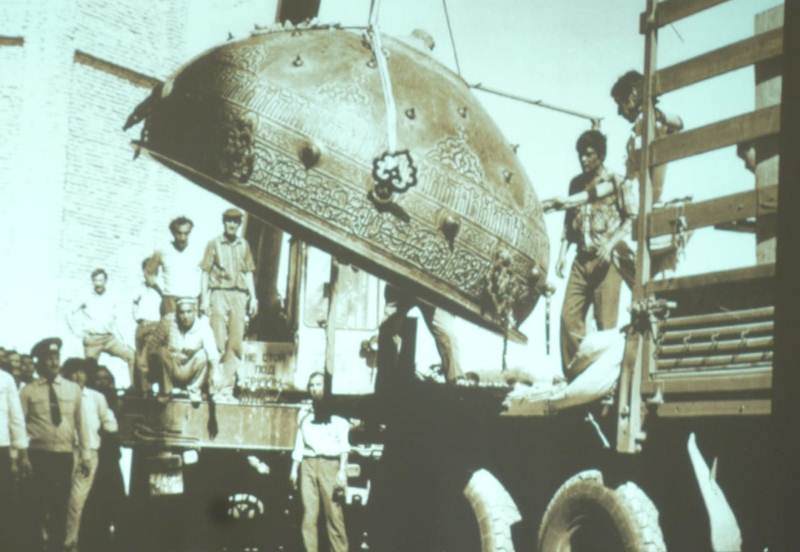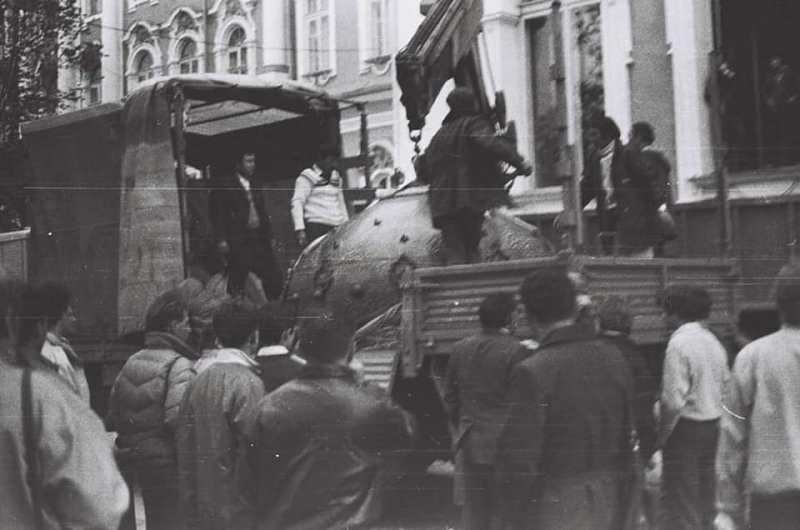Вы здесь
Return of Tai-Kazan to mausoleum of Akhmed Yasawi.



Sufi places in Turkestan.
“And he made a cast [sea of copper] sea, from its end to the end of his ten cubits, - completely round, five elbows high, and a thirty-elbow beast hugged him around. It was thick in the palm of the hand, and its edges, made like the edges of a bowl, were like a blossoming lily. It held two thousand baht."
"Old Testament". The first temple of King Solomon.
Pilgrimage to Turkestan to holy places.
In 1935, Tai-Kazan was delivered from the city of Turkestan to the State Hermitage Museum in Leningrad. Initially, it was planned that Tai-Kazan would be in the Hermitage for only three months. This need was caused in connection with the III International Congress on Iranian Art and Archeology, which was supposed to be held in Leningrad.
The Second International Congress on Iranian Art, convened in January 1931 in London, in the halls of the Academy of Arts, at Burlington Palace, recognized that it would be desirable for the next congress to be convened in Leningrad, on the basis of the State Hermitage Museum, whose collections on Iran’s culture and art are exceptionally large interest.
In accordance with this wish, by decision of the Soviet Government, the Third International Congress on Iranian Art and Archeology was convened in September 1935 in Leningrad and held its classes from September 11 to 16 in the Hermitage, and two final meetings were held in Moscow, in the House of the Red Army .
The Congress was attended by 188 delegates and 153 competing members representing 18 countries: Austria, England, Afghanistan, Germany, Holland, Denmark, Iran, Spain, Palestine, Poland, Syria, the United States of America, the USSR, Turkey, Finland , France, Czechoslovakia and Sweden.
In connection with the Congress, the Department of the East of the Hermitage opened a large exhibition in 84 halls, where, together with the richest collections of the Hermitage, exhibits from a number of other Soviet museums were presented: from the RSFSR, Azerbaijan, Armenia, Georgia, Kazakhstan, Turkmenistan and Ukraine.
The Iranian government provided exhibits with astonishing magnificence, originating from both the Iranian museums and the Muslim sanctuaries of Iran, usually inaccessible to most researchers. Beautiful Sasanian silver vessels and piece reliefs were presented at the exhibition by the Louvre Museum. Interesting exhibits were delivered by Professor Arthur Poop from collections belonging to both him and foreign collectors sharing his attachment to Iranian art.
A valuable collection of photographs of monuments of Iranian architecture was sent to the exhibition by the American Institute of Iranian Art and Archeology. In preparation for the congress, scientists from the USSR prepared a series of excellent publications, which today constitute the pride of Russian science.
A series of postage stamps was issued, a special medal was struck. Tai-Kazan from the Kazakh city of Turkestan was to take one of the worthy places in the days of the congress and be one of the first unique exhibits.
In those ancient times, in the center of the main hall of Kazandyk in the mausoleum of Ahmed Yasavi, square in shape, the length of the sides of which is 18.2 meters, and the height of the hall reaches 39 meters. The spherical conical dome of the Kazandyk Hall is considered the largest of the existing structures that are currently located in Central Asia.
The Kazandyk Hall embodied the full greatness of the giant Tai-Kazan in the mausoleum of Khoja Ahmed Yasawi. But in a brief annotation about the ancient relic, which was installed after 1935, it was written: “Tai-Kazan, bronze, diameter 2.42 meters, capacity - 2000 liters. It was used to distribute water from a sacred source to pilgrims.
It is on permanent display at the Hermitage in Leningrad.” Perplexed were many believers and pilgrims who visited the mausoleum and read this information, could not do anything, they just silently contemplated the obvious, instead of a masterpiece, people saw only a photograph with a sign.
In 1989, a great event took place in the history of Kazakhstan; Tai-Kazan was returned to Kazakhstan to its historical homeland and is rightfully considered a masterpiece of decorative and applied art. A little story about Tai-cauldron.
The word “kazan” is a borrowing from the Turkic languages, where it has become a suffix derivative of the word “kaz”, which can be translated as “scratch, rub”, that is, “kazan” is literally “scraped out” (vessel). The largest cauldrons are designed for cooking large quantities of meat, they are called tai-cauldron (tai - a foal or a goby older than a year).
The cauldron is installed in stationary (stone, adobe, earthen), portable metal foci of cylindrical shape, as well as on a special metal tripod - tagan. A simple stationary hearth is a single hearth, made of stones and clay, with a large round hole at the top where the cauldron is installed.
More complex foci are modern cooking stoves with chimneys and several, usually three, cauldrons of different sizes. Due to the hearth, which cools for a long time due to the heat capacity of its walls and smoldering coals, some dishes (for example, pilaf or smoke) are not brought to readiness on a fire flame.
With the flame extinguished, the dish is stewed for a while in a hot hearth. The times of Temur's reign were merciless, huge masses of people were destroyed in the space from Central Asia to Europe, but by how much, Temur was merciless in proportion and he cared about the revival of the culture of his land. It is difficult for contemporaries to understand the combination of cruelty and culture, these are two different polar things, but the fact remains.
During the five-year war, Temur’s troops captured Western Iran, his troops returned from the campaign with great booty, among the captured captives was a bronze master, Abdulgaziz ibn Sharafutdin, who knew how to work with bronze.
Then, on the order of Temur, the master Abdulgaziz ibn Sharafutdin was sent to the city of Karnak to prepare the casting of the famous boiler for the mausoleum of Khoja Ahmed Yassawi. The village of Karnak, until 1992 was called the village of Atabay, this small village located in the Turkestan region, is subordinate to the city administration of Kentau, is located about 12 kilometers west of the city of Kentau. In ancient times, the city of Karnak existed from the IXth to the XVIIth centuries.
At the end of the XIV - beginning of the XV century, Karnak was part of the empire of Amir Temur, which was located in the foothills of Karatau. The experienced master Abdulgaziz ibn Sharafutdin did not choose this place for the purpose of preparing works and further manufacturing a huge cauldron.
The mountains of Karatau hide in their bowels deposits of minerals, metal ores and have an ancient history of metal smelting. Soviet archaeologist M. Masson suggested that there were already metallurgical furnaces in the place of casting the cauldron, in which people in ancient times manufactured metal products.
The master used alloys of seven metals for casting a cauldron - iron, zinc, lead, tin, red copper, silver and gold. He decorated the cauldron with floral ornaments, ornate Arabic script. In the outer circle on Tai-kazan there are three belts of 10 massive sheer handles.
Sheer handles on the cauldron, the master gave him an elegant form of lotus petals, the handles are movable due to the hinge. The size of the cauldron is impressive, its height is 162 centimeters, and its diameter is 242 centimeters, the weight of Tai-cauldron is 2 tons.
The Tai-kazan was intended for sweetened water, which was distributed as orthodox after Friday prayers during a public memorial meal. According to the ancient legend, after drinking water from it, the pilgrim is forever cleansed of contamination.
Further, the legend says that when water was poured into it, Tai-Kazan contained about three tons of water, the water remained healing, and the water temperature did not change. The inscription on Tai-kazan indicates the date of its manufacture - 20 shavval 801, historians confirm this date - June 25, 1399.
So the date of the great a masterpiece of world decorative foundry art, today (October 2019), Toy Kazan is celebrating its 620th anniversary. A little more than half a century, 55 years, Tai-cauldron was outside its historical place.
We return to the beginning of the article about the sad history of Tai-Kazan, when the relic was taken to the Hermitage in preparation for the opening of the Third Congress of Iranian Art. So that Tai-Kazan was not alone at the exhibition in the Hermitage, two large bronze candlesticks were sent for the company from the mausoleum of Ahmed Yasawi.
Today in the mausoleum of Ahmed Yasavi in Turkestan there are 6 bronze lamps and candlesticks painted with Arabic script and inlaid with gold and silver. September 13, 1989, preparations began for the transportation of the legendary Toy Kazan from the State Hermitage to Kazakhstan.
The initiator of the return of Tai-Kazan was the secretary of the Turkestan district executive committee Erkin Jurabekov. In the mid 80-ies of the XX century E. Dzhurabekov served as secretary of the district executive committee of the Turkestan region of the South Kazakhstan region and made an invaluable contribution to the multiplication and development of the culture of Kazakhstan.
Invaluable help and contribution to the return of Tai-Kazan to Turkestan was made by Uzbekali Dzhanibekov, who worked as deputy minister of culture of the Kazakh SSR from 1977 to 1984, and in 1987 - 1988 was the minister of culture of the republic.
It should also be noted that the director of the Hermitage, academician Boris Borisovich Piotrovsky, played an important role in the return of the toy cauldron to Kazakhstan. On September 18, 1989, the toy-kazan was delivered to the central part of the Kazandyk Hall in the mausoleum of Ahmed Yasavi.
It should be noted that after the delivery of Tai-Kazan to the mausoleum, large restoration work began in the mausoleum. A copy of the receipt, which stated that Tai-Kazan was borrowed to the Hermitage only for the preparation and holding of the International Congress, which was to be held in Leningrad in September 1935 and after September 16, had a positive role in the return of Tai-Kazan to Kazakhstan. at the end of the congress, Tai-kazan was guaranteed to return.
In the 80s of the last century, for a long time, Zhanibekov negotiated with the leadership of the Hermitage and the Ministry of Culture of the USSR on the return of the shrine. Zhanibekov made repeated trips to Leningrad to Moscow.
To speed up the issue of returning Tai-Kazan, a representative delegation was sent from Kazakhstan to Moscow, which staged a strike and gradually resolved the issue with joint efforts. Finally, the necessary permits were obtained on July 25, 1989, but technical issues arose with the transportation of Tai-Kazan outside the Hermitage’s Oriental Art Hall.
A high-class master of his craft came to the rescue - a crane operator, who managed to transport Toy-cauldron out of the window, skillfully manipulating the crane's arrow. A car was sent from Turkestan to Leningrad to deliver valuable cargo to the mausoleum, and on September 18, 1989, Toy Kazan returned home.
And in the Hermitage to this day, magnificent bronze candlesticks from the mausoleum of Ahmed Yasavi, which were removed back in 1934, are carefully preserved and preserved.


Authority:
Alexander Petrov. When writing an article, materials from open sources were used.
Photos used
from the exhibition “Returned Exhibits” in honor of the 620th anniversary of the casting of the holy Taikazan and the 30th anniversary of his return to the historical site. G. Turkestan. 2019.







